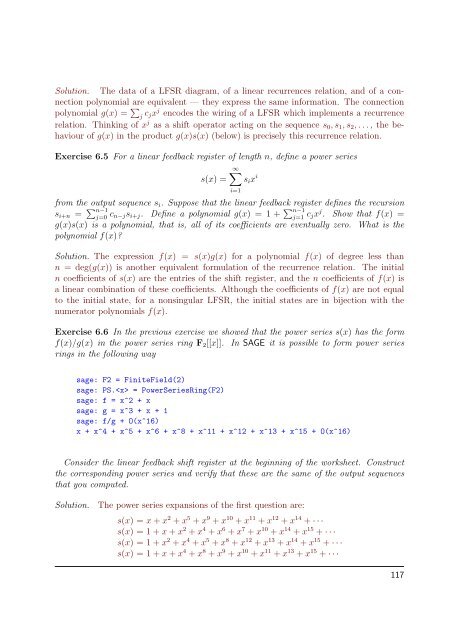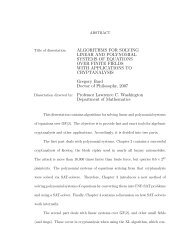Cryptography - Sage
Cryptography - Sage
Cryptography - Sage
You also want an ePaper? Increase the reach of your titles
YUMPU automatically turns print PDFs into web optimized ePapers that Google loves.
Solution. The data of a LFSR diagram, of a linear recurrences relation, and of a connectionpolynomial are equivalent — they express the same information. The connectionpolynomial g(x) = ∑ j c jx j encodes the wiring of a LFSR which implements a recurrencerelation. Thinking of x j as a shift operator acting on the sequence s 0 , s 1 , s 2 , . . . , the behaviourof g(x) in the product g(x)s(x) (below) is precisely this recurrence relation.Exercise 6.5 For a linear feedback register of length n, define a power series∞∑s(x) = s i x ifrom the output sequence s i . Suppose that the linear feedback register defines the recursions i+n = ∑ n−1j=0 c n−js i+j . Define a polynomial g(x) = 1 + ∑ n−1j=1 c jx j . Show that f(x) =g(x)s(x) is a polynomial, that is, all of its coefficients are eventually zero. What is thepolynomial f(x)?Solution. The expression f(x) = s(x)g(x) for a polynomial f(x) of degree less thann = deg(g(x)) is another equivalent formulation of the recurrence relation. The initialn coefficients of s(x) are the entries of the shift register, and the n coefficients of f(x) isa linear combination of these coefficients. Although the coefficients of f(x) are not equalto the initial state, for a nonsingular LFSR, the initial states are in bijection with thenumerator polynomials f(x).Exercise 6.6 In the previous exercise we showed that the power series s(x) has the formf(x)/g(x) in the power series ring F 2 [[x]]. In SAGE it is possible to form power seriesrings in the following wayi=1sage: F2 = FiniteField(2)sage: PS. = PowerSeriesRing(F2)sage: f = x^2 + xsage: g = x^3 + x + 1sage: f/g + O(x^16)x + x^4 + x^5 + x^6 + x^8 + x^11 + x^12 + x^13 + x^15 + O(x^16)Consider the linear feedback shift register at the beginning of the worksheet. Constructthe corresponding power series and verify that these are the same of the output sequencesthat you computed.Solution.The power series expansions of the first question are:s(x) = x + x 2 + x 5 + x 9 + x 10 + x 11 + x 12 + x 14 + · · ·s(x) = 1 + x + x 2 + x 4 + x 6 + x 7 + x 10 + x 14 + x 15 + · · ·s(x) = 1 + x 2 + x 4 + x 5 + x 8 + x 12 + x 13 + x 14 + x 15 + · · ·s(x) = 1 + x + x 4 + x 8 + x 9 + x 10 + x 11 + x 13 + x 15 + · · ·117
















